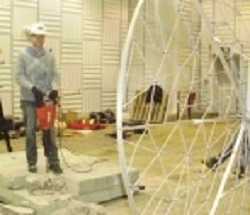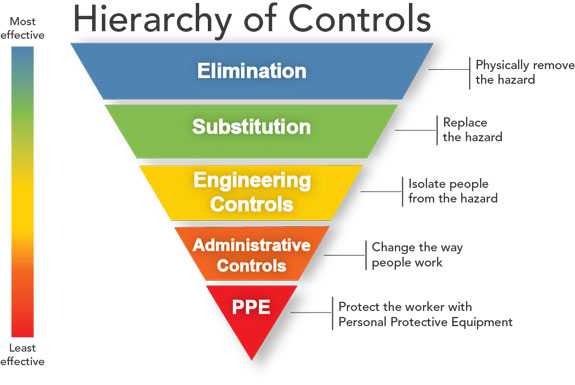Controls for Noise Exposure

Overview
Loud noise at work can damage hearing. Approximately 22 million U.S. workers are exposed to hazardous noise at work. To minimize occupational noise-induced hearing loss, the National Institute for Occupational Safety and Health (NIOSH) recommends that workers should not be exposed to noise at a level that amounts to more than 85 decibels (dBA) for 8 hours. To create a more healthful workplace, NIOSH recommends an approach based on the hierarchy of control.
The Hierarchy of Control
Occupational safety and health professionals use the hierarchy of control (shown in the figure below) to determine how to implement feasible and effective controls. This approach groups actions by their likely effectiveness in reducing or removing the noise hazard.
In most cases, the preferred approach is to eliminate the source of hazardous noise. When elimination is not possible, substitution of the loud equipment for quieter equipment may be the next best alternative to protect workers from hazardous noise. If the hazardous noise cannot be controlled through elimination of the source or substitution of quieter equipment, engineering controls may be installed to reduce noise to safer levels or remove noise at the source.
Engineering controls require physical changes to the workplace such as redesigning equipment to eliminate noise sources and constructing barriers that prevent noise from reaching a worker. If it is not possible to remove the hazard through elimination, substitution or engineering controls, the next step is to reduce noise exposure through the use of administrative controls. For example, an employer may change an employee’s work schedule to avoid too much noise.
Personal protective equipment (PPE), such as ear plugs or other hearing protection devices, is the last option in the hierarchy of control. PPE is generally less effective than elimination, substitution, and engineering controls because they rely on human actions to reduce noise. Used in combination with other levels of control, such as administrative controls, PPE may provide worker protection when engineering controls do not adequately remove the noise hazard.
NIOSH encourages occupational safety and health professionals, employers, and workers to learn more about controls for hazardous noise exposure. Consult a workplace safety and health professional to determine solutions for your work setting and employees.

Solutions for Reducing Noise in the Workplace
Occupational safety and health professionals and employers can take the following actions to reduce noise in the workplace. Consider these solutions when creating your hearing loss prevention program:
- Buy Quiet - select and purchase low-noise tools and machinery
- Maintain tools and equipment routinely (such as lubricate gears)
- Reduce vibration where possible
- Isolate the noise source in an insulated room or enclosure
- Place a barrier between the noise source and the employee
- Isolate the employee from the source in a room or booth (such as sound wall or windows)
To learn more about these strategies and review case studies, visit the Industrial Noise Control Manual, DHHS (NIOSH) Publication No. 79-117.
Buy Quiet

NIOSH and its partners have led efforts to promote Buy Quiet initiatives including the development of a NIOSH Power Tools Database to make noise data available to tool buyers, users, and manufacturers of powered hand tools. NIOSH held a Buy Quiet Workshop in 2012 and is continuing to develop additional web tools and guidance for use by organizations when implementing Buy Quiet programs. To learn more, visit our Buy Quiet website.
Join us to help promote Buy Quiet by raising awareness among workers and employers. Be part of a nationwide effort to reduce noise-induced hearing loss. Read about it on the NIOSH Science Blog and contact the NIOSH Division of Applied Research and Technology, Engineering and Physical Hazards Branch, Hearing Loss Prevention Team at 513-841-4221 to learn more.
NIOSH Noise Control Publications and Related Websites
- Criteria for a Recommended Standard: Occupational Noise Exposure
DHHS (NIOSH) Publication Number 98-126
Reevaluates and reaffirms the recommended exposure limit (REL) for occupational noise exposure which NIOSH set in 1972. - Industrial Noise Control Manual
DHHS (NIOSH) Publication No. 79-117
Contains essential information about noise control technology, as well as a collection of 61 case histories describing successful noise control projects. - Preventing Occupational Hearing Loss – A Practical Guide
DHHS (NIOSH) Publication No. 96-110
Assists employers and employees to develop and maintain hearing loss prevention programs that work. - Health Hazard Evaluations: Noise and Hearing Loss, 1986-1997
DHHS (NIOSH) Publication No. 99-106
Presents summaries, by industry, of different health hazard evaluations performed for exposures to noise. - Noise and Hearing Loss Prevention
Presents NIOSH’s primary information on Noise and Hearing Loss Prevention. - NIOSH Power Tools Database
Contains information such as sound power levels, sound pressure levels and downloadable exposure files. - Mining Topic: Hearing Loss Prevention Overview
Presents NIOSH’s primary information on Noise and Hearing Loss Prevention in the mining industry. - Safe in Sound: Excellence in Hearing Loss Prevention
NIOSH has partnered with the National Hearing Conservation Association (NHCA) to create an award for Excellence in Hearing Loss Prevention.
Provides case examples of Excellence in Hearing Loss Prevention and Noise Control.
Key Resources from Our Partners
- Occupational Noise Exposure
Department of Labor Occupational Safety and Health Administration (OSHA).
Provides a central online source of references and publications related to controlling workplace noise hazards. - OSHA Technical Manual – Noise. Occupational Safety and Health Administration. Chapter V, Hazard Abatement and Control
Provides case studies for noise control and Buy-Quiet. - Controlling Noise on Construction Sites
Laborer's Health and Safety Fund of North America (LHSFNA).
Describes how to evaluate and control noise hazards at construction sites. Additional resources on noise are also provided. - Buy Quiet Process Roadmap
EARLAB, National Aeronautics and Space Administration (NASA) Auditory Demonstration Laboratory.
Presents an educational tool and resource related to Buy Quiet concepts.
- Page last reviewed: January 24, 2014
- Page last updated: December 2, 2016
- Content source:
- National Institute for Occupational Safety and Health Division of Applied Research and Technology (DART)



 ShareCompartir
ShareCompartir